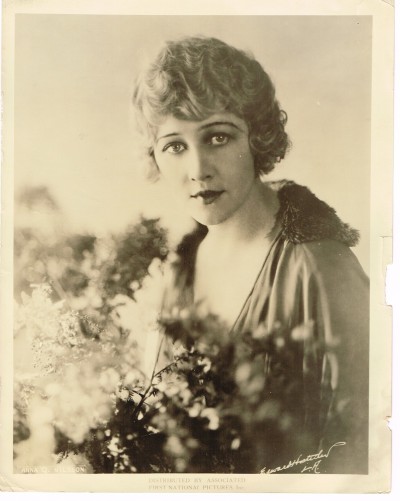Anna Q. Nilsson (Anna Quirentia Nilsson)

Anna Q. Nilsson was born in Ystad, Skåne County, Sweden in 1888. Her middle name, “Quirentia ” is derived from her date of birth, March 30 Saint Quirinius’ Day. When she was 8 years old her father got a job at the local sugar factory in Hasslarp, a small community outside Helsingborg in Sweden where she spent most of her school years. She did very well in school, graduating with highest marks. Due to her good grades she was hired as a sales clerk in Halmstad on the Swedish west coast, unusual for a young woman from a worker’s family at the time. But she had set her mind on going to America. In 1905, she immigrated to the United States through Ellis Island. In the new country, the Swedish teenager started working as a nursemaid and learned English quickly. Soon she started working as a model. In 1907, she was named “Most beautiful woman in America”. Penrhyn Stanlaws (1877–1957), one of the most successful and sought after cover artists of his day, picked Anna Q. Nilsson to become one of his models. Nilsson’s modeling led her to getting a role in Kalem’s 1911 film Molly Pitcher. Another beauty who began appearing in Kalem films at the same time was Alice Joyce. Films of special note for Anna were Regeneration (1915) Seven Keys to Baldpate (1917), Soldiers of Fortune (1919), The Toll Gate and The Luck of the Irish (both 1920), and The Lotus Eater (1921). She stayed at the Kalem studio for several years, ranked behind their top star Alice Joyce. In the 1920s, she freelanced successfully for Paramount, First National and many other studios and reached a peak of popularity just before the advent of talkies, despite a serious horse-riding accident which kept her from filming for almost two years. In 1923, she portrayed “Cherry Malotte” in the second movie based upon Rex Beach’s The Spoilers, a role that would be played in later versions by Betty Compson (1930), Marlene Dietrich (1942), and Anne Baxter (1955).
In 1921, she returned to Sweden to film Värmlänningarna, her only Swedish movie. In 1926, she was named Hollywood’s most popular woman. She welcomed royalty when the Swedish Crown Prince Gustav Adolf (later King Gustaf VI Adolf) and his wife Louise Mountbatten visited Hollywood. In 1928, she struck a record of fan mail, 30,000 letters a month, and that year Joseph P. Kennedy brought her to his newly formed film company RKO Radio Pictures. The following year, as she was horse riding, she fell off the horse, was thrown against a stone wall and broke her hip. After a year of hard training, she was on her feet again. In 1928, Anna Nilsson made her last film of the silent era, Blockade. With the introduction of sound films, Nilsson’s career went into a sharp decline, although she continued to play small, often uncredited parts in films into the 1950s. Between 1930 and 1950, she participated in 39 sound films, in smaller roles. She played the role of the Swedish immigrant mother of Loretta Young in The Farmer’s Daughter (1947). Her best known performance in a sound film is arguably her turn as “herself”, referred to as one of Swanson’s “waxworks” in the classic film Sunset Boulevard (1950), where she has one small line. Anna was married to actor Guy Coombs (1916) and to Norwegian-American shoe merchant John Marshall Gunnerson (1923–25). Nilsson has a star on the Hollywood Walk of Fame at 6150 Hollywood Boulevard for her contribution to motion pictures. She was the first Swedish-born actress to receive such an honor. She died in Sun City, California, on February 11, 1974, of heart failure.
Born
- March, 30, 1888
- Ystad, Sweden
Died
- February, 11, 1974
- USA
- Sun City, California
Cause of Death
- heart failure
Other
- Cremated


